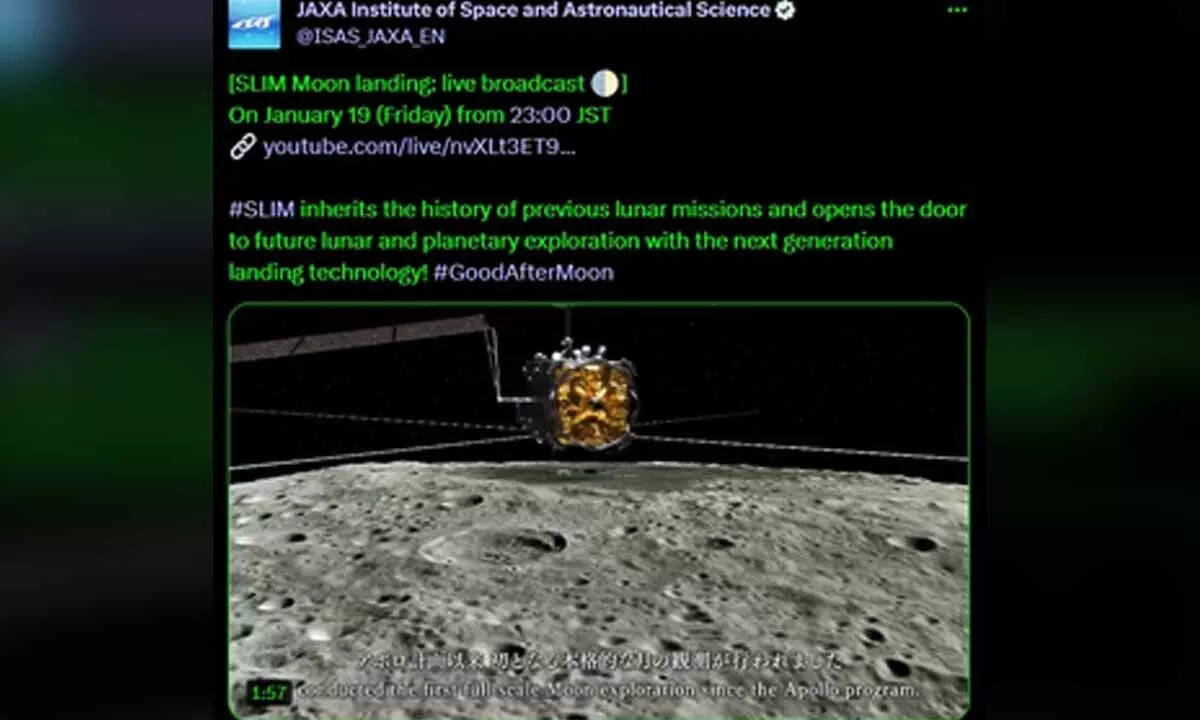Japan's Moon sniper appears to ace 1st ever pin-point Moon landing on Friday
Share :

Japan appears to have become the fifth country to successfully land on the Moon, after Russia, US, China, and India.
Tokyo: Japan appears to have become the fifth country to successfully land on the Moon, after Russia, US, China, and India.
The Japan Aerospace Exploration Agency (JAXA) on Friday said that Smart Lander for Investigating Moon (SLIM) appears to have successfully made a "precision landing" on the Moon.
However, the agency is yet to confirm its status.
"From the telemetry, what we see is the SLIM has landed," a spokesperson with the JAXA said during live commentary of the landing this morning.
"We are now checking the status." JAXA said that SLIM, also known as "Moon Sniper" in Japanese, achieved a pinpoint landing within 100 metres of the target, as planned.
The 2.7 metres SLIM touched down on the lunar surface at about 10.20 a.m. EST (8.50 p.m. IST).
It was launched on September 6 along with XRISM, a powerful X-ray space telescope.
SLIM landed on the slope of Shioli Crater, a relatively fresh, 300-metre-wide impact feature within Mare Nectaris, at 13 degrees south latitude and 25 degrees east longitude on the near side of the moon.
SLIM is a cargo research mission, carrying a variety of scientific payloads, including an analysis camera and a pair of lunar rovers.
During the live streaming, JAXA explained that the SLIM is armed with a navigation camera, SLIM could spot craters/boulders on the lunar surface.
While descending onto the lunar surface, the "vision-based navigation" enabled it to find the exact location, matching its camera’s images with existing satellite photos of the moon.
"This marks an unprecedentedly high-precision landing on a gravitational body such as the Moon, and the results are anticipated to contribute to the programmes such as international space exploration that are currently under study," the agency had said in an earlier statement.
The soft landing has been a tricky issue as it involves a series of complex manoeuvres consisting of rough and fine braking.
Japan has previously failed in two lunar landing attempts.
JAXA lost contact with the OMOTENASHI lander and scrubbed an attempted landing in November, while the Hakuto-R Mission 1 lander, by Japanese startup ispace, crashed in April as it attempted to descend to the lunar surface.
In 2019, two attempted lunar landings, by India’s Chandrayaan-2 and Israeli nonprofit SpaceIL's Beresheet, had crashed. In those landing attempts, the trajectory and speed data went awry before the signals were lost.
In August 2023, Russia's Luna-25 lander crashed while approaching the moon.
However, India’s Chandrayaan-3 mission, led by scientists at ISRO, became the first nation in the world to land near the south pole of the Moon last year, and the fourth nation to make a soft landing on the Moon after the erstwhile USSR, the US, and China.
The lander landed near the South Pole of the moon after travelling about 3.84 lakh km for over 40 days.
Last week, NASA-backed Astrobotic Technology’s Peregrine lunar l mission that aimed to put America back to the lunar terrain after about 50 years, was unsuccessful. The US’ first fully private spacecraft “will not" make the historic landing on the Moon, the company announced.
Pittsburgh-based Astrobotic’s Peregrine lunar l which lifted off on January 8 suffered an "anomaly", and the officials found a critical loss of propellant due to "the failure within the propulsion system".
Another Houston-based Intuitive Machines also aims to launch a lander to the Moon in mid-February on SpaceX’s Falcon 9 rocket.
The lunar missions come as the US has not attempted a moon landing since Apollo 17 in December 1972.
















